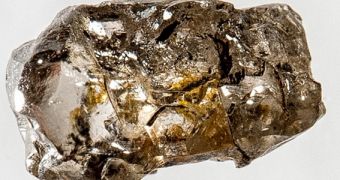Researchers from the University of Alberta in Edmonton, Canada, led by mantle geochemist Graham Pearson, announce the discovery of microscopic samples of a weird mineral in a small diamond collected from Brazil. This mineral has never been observed in terrestrial rocks before, and the team says that it points at the fact that massive water reserves may be stored in Earth's mantle.
The diamond in question weighs less than one-tenth of a gram and is just 5 millimeters (0.19 inches) long. Unlike regular diamonds, which form in the mantle at a depth of 150 to 200 kilometers (93 to 124 miles), this ultra-deep sample formed in the transition zone, between 410 and 660 kilometers (258 to 410 miles) below the surface. This is roughly equal to the altitude of the International Space Station.
The UA team published details of their discovery in the March 12 issue of the top scientific journal Nature. Researchers with the group say that additional studies of this peculiar diamond could finally reveal new data on the origins of water on Earth, a topic that is still hotly debated in the international scientific community, Nature News reports.
Fortunately, not all diamonds are pure. Those that contain impurities can provide large amounts of data on the conditions in the particular area of the mantle where they form, so scientists use them as depth probes to study the interior of our planet. One of the most important aspects in this line of study is to figure out what minerals are present at what depths under the surface.
“These high-pressure diamonds give you a window into the deep Earth,” says Pearson. He adds that some minerals deep underground remain trapped in diamonds and do not get destroyed on their way up to the surface. By using a light-scattering study method called Raman spectroscopy, the UA group was able to identify such a mineral in the Brazilian diamond.
The 40-micrometer sample contains a form of olivine called ringwoodite, which only forms under extreme pressures. This material accounts for much of Earth's upper mantle, but it has until now been found in nature only in meteorites. Additional samples have been synthesized in the lab.
Unlike olivine and related minerals, ringwoodite can hold vast amounts of water, suggesting that the upper mantle may in fact be a huge reservoir of water. Geologists have been trying to determine exactly how much water is found in the mantle transition zone for many years, and this study may go a long way towards settling that debate.
The Nature study revealed that around 1 percent of the ringwoodite sample's mass was accounted for by water. “That may not sound like much, but when you realize how much ringwoodite there is, the transition zone could hold as much water as all the Earth’s oceans put together,” Pearson reveals.
While other scientists agree that the findings are significant, they urge caution in jumping to any conclusions too rashly. Stanford University geophysicist Norm Sleep says that the ringwoodite sample may not be representative for the entire mantle, adding that additional studies are required to confirm the Canadian team's conclusions.
“It would be unwise to assume that all the gravel in the stream is gold nuggets,” Sleep explains.

 14 DAY TRIAL //
14 DAY TRIAL //